Swamp Wetlands in Degraded Permafrost Areas Release Large Amounts of Methane and May Promote Wildfires through Friction Electrification
Abstract
:1. Introduction
2. Study Area Descriptions
3. Results
3.1. Methane Emissions from Permafrost Regions in Northeast China
3.2. Atmospheric Electrodischarge and Static Electricity Formation Mechanisms and Near-Surface Atmospheric Electric Fields Associated with the Methane Emission Process in Permafrost Areas
3.3. Analyses of the Characteristics of Burned Sites, Changes in the Atmospheric Electric Field, and Related Monitoring Data in the Study Area
4. Establishment of the Conceptual Model
5. Discussion
6. Conclusions
Author Contributions
Funding
Institutional Review Board Statement
Informed Consent Statement
Data Availability Statement
Conflicts of Interest
References
- Isaksen, I.S.A.; Gauss, M.; Myhre, G.; Anthony, K.M.W.; Ruppel, C. Strong atmospheric chemistry feedback to climate warming from Arctic methane emissions. Glob. Biogeochem. Cycles 2011, 25, GB2002. [Google Scholar] [CrossRef]
- Walter, K.M.; Zimov, S.A.; Chanton, J.P.; Verbyla, D.; Chapin, F.S. Methane bubbling from Siberian thaw lakes as a positive feedback to climate warming. Nature 2006, 443, 71–75. [Google Scholar] [CrossRef] [PubMed]
- Xu, X.; Tian, H. Methane exchange between marshland and the atmosphere over China during 1949–2008. Glob. Biogeochem. Cycles 2012, 26, GB2006. [Google Scholar] [CrossRef]
- Xu, X.F.; Tian, H.Q.; Zhang, C.; Liu, M.L.; Ren, W.; Chen, G.S.; Lu, C.Q.; Bruhwiler, L. Attribution of spatial and temporal variations in terrestrial methane flux over North America. Biogeosciences 2010, 7, 3637–3655. [Google Scholar] [CrossRef] [Green Version]
- Schuur, E.A.G.; McGuire, A.D.; Schädel, C.; Grosse, G.; Harden, J.W.; Hayes, D.J.; Hugelius, G.; Koven, C.D.; Kuhry, P.; Lawrence, D.M.; et al. Climate change and the permafrost carbon feedback. Nature 2015, 520, 171–179. [Google Scholar] [CrossRef] [PubMed]
- Dallimore, S.R.; Collett, T.S. Intrapermafrost gas hydrates from a deep core hole in the Mackenzie Delta, Northwest Territories, Canada. Geology 1995, 23, 527–530. [Google Scholar] [CrossRef]
- Yakushev, V.; Chuvilin, E. Natural gas and gas hydrate accumulations within permafrost in Russia. Cold Reg. Sci. Technol. 2000, 31, 189–197. [Google Scholar] [CrossRef]
- Hugelius, G.; Strauss, J.; Zubrzycki, S.; Harden, J.W.; Schuur, E.A.G.; Ping, C.-L.; Schirrmeister, L.; Grosse, G.; Michaelson, G.J.; Koven, C.D.; et al. Estimated stocks of circumpolar permafrost carbon with quantified uncertainty ranges and identified data gaps. Biogeosciences 2014, 11, 6573–6593. [Google Scholar] [CrossRef] [Green Version]
- Wang, X.; Li, X.; Hu, Y.; Lv, J.; Sun, J.; Li, Z.; Wu, Z. Effect of temperature and moisture on soil organic carbon mineralization of predominantly permafrost peatland in the Great Hing’an Mountains, Northeastern China. J. Environ. Sci. 2010, 22, 1057–1066. [Google Scholar] [CrossRef]
- Burke, S.A.; Wik, M.; Lang, A.; Contosta, A.R.; Palace, M.; Crill, P.M.; Varner, R.K. Long-Term Measurements of Methane Ebullition From Thaw Ponds. J. Geophys. Res. Biogeosci. 2019, 124, 2208–2221. [Google Scholar] [CrossRef]
- Yun, H.; Wu, Q.; Zhuang, Q.; Chen, A.; Yu, T.; Lyu, Z.; Yang, Y.; Jin, H.; Liu, G.; Qu, Y.; et al. Consumption of atmospheric methane by the Qinghai–Tibet Plateau alpine steppe ecosystem. Cryosphere 2018, 12, 2803–2819. [Google Scholar] [CrossRef] [Green Version]
- Kharuk, V.I.; Ponomarev, E.I. Spatiotemporal characteristics of wildfire frequency and relative area burned in larch-dominated forests of Central Siberia. Russ. J. Ecol. 2017, 48, 507–512. [Google Scholar] [CrossRef]
- Zhou, Y.W. Frozen Soil in China; Science Press: Beijing, China, 2000. (In Chinese) [Google Scholar]
- Chunjiao, W.; Monan, S.; Zhaoguang, H.; Wei, S. Multi-spectral remote sensing based land surface temperature retrieval and isolated permafrost zone segmentation. Infrared Laser Eng. 2015, 44, 1390–1396. (In Chinese) [Google Scholar]
- Wei, Z.; Jin, H.; Zhang, J.; Yu, S.; Han, X.; Ji, Y.; He, R.; Chang, X. Prediction of permafrost changes in Northeastern China under a changing climate. Sci. China Earth Sci. 2011, 54, 924–935. [Google Scholar] [CrossRef]
- Sun, G.Y. Discussion on the symbiotic mechanisms of swamp with permafrost-Taking Da-Xiao Hinggan Mountains as examples. J. Glaciol. Geocryol. 2000, 22, 309–316. (In Chinese) [Google Scholar]
- Guo, D.X.; Wang, S.L.; Lu, G.W.; Dai, J.B.; Li, E.Y. Division of permafrost regions in Daxiao Hinggan Ling northeast China. J. Glaciol. Geocryol. 1981, 3, 1–9. (In Chinese) [Google Scholar]
- Jin, H.; Yu, Q.; Lü, L.; Guo, D.; He, R.; Yu, S.; Sun, G.; Li, Y. Degradation of permafrost in the Xing’anling Mountains, northeastern China. Permafr. Periglac. Process. 2007, 18, 245–258. [Google Scholar] [CrossRef]
- Zuo, H.C.; Lu, S.H.; Hu, Y.Q. Variations trend of yearly mean air temperature and precipitain in China in the last 50 years. Plateau Meteorol. 2004, 23, 238–244. (In Chinese) [Google Scholar]
- Ren, G.Y.; Guo, J.; Xu, M.Z. Climate changes of China’s mainland over the past half century. Acta Meteorol. Sin. 2005, 63, 942–956. (In Chinese) [Google Scholar]
- He, W.; Bu, R.C.; Xiong, Z.P.; Hu, Y.M. Characteristics of temperature and precipitation in Northeastern China from 1961 to 2005. Acta Ecol. Sin. 2013, 33, 519–531. (In Chinese) [Google Scholar] [CrossRef]
- Song, C.; Xu, X.; Sun, X.; Tian, H.; Sun, L.; Miao, Y.; Wang, X.; Guo, Y. Large methane emission upon spring thaw from natural wetlands in the northern permafrost region. Environ. Res. Lett. 2012, 7, 034009. [Google Scholar] [CrossRef] [Green Version]
- IPCC. Summary for Policymakers. In Climate Change 2021: The Physical Science Basis. Contribution of Working Group I to the Sixth Assessment Report of the Intergovernmental Panel on Climate Change; Cambridge University Press: Cambridge, UK, 2021; in press. [Google Scholar]
- Shvidenko, A.Z.; Schepaschenko, D.G. Climate change and wildfires in Russia. Contemp. Probl. Ecol. 2013, 6, 50–61. [Google Scholar] [CrossRef]
- Shan, W.; Xu, Z.; Guo, Y.; Zhang, C.; Hu, Z.; Wang, Y. Geological methane emissions and wildfire risk in the degraded permafrost area of the Xiao Xing’an Mountains, China. Sci. Rep. 2020, 10, 21297. [Google Scholar] [CrossRef] [PubMed]
- Tokida, T.; Mizoguchi, M.; Miyazaki, T.; Kagemoto, A.; Nagata, O.; Hatano, R. Episodic release of methane bubbles from peatland during spring thaw. Chemosphere 2007, 70, 165–171. [Google Scholar] [CrossRef] [PubMed]
- Klein, A. Volcano Eruption in Tonga Was a Once-in-a-Millennium Event. News Scientist. 2022. Available online: https://www.newscientist.com/article/2304822-volcanoeruption-in-tonga-was-a-once-in-a-millennium-event/ (accessed on 17 January 2022).
- Ye, L.; Kanamori, H.; Rivera, L.; Lay, T.; Zhou, Y.; Sianipar, D.; Satake, K. The 22 December 2018 tsunami from flank collapse of Anak Krakatau volcano during eruption. Sci. Adv. 2020, 6, eaaz1377. [Google Scholar] [CrossRef] [PubMed] [Green Version]
- Kaponig, M.; Mölleken, A.; Nienhaus, H.; Möller, R. Dynamics of contact electrification. Sci. Adv. 2021, 7, eabg7595. [Google Scholar] [CrossRef] [PubMed]
- Anderson, R.; Gathman, S.; Hughes, J.; Björnsson, S.; Jónasson, S.; Blanchard, D.C.; Moore, C.B.; Survilas, H.J.; Vonnegut, B. Electricity in Volcanic Clouds. Science 1965, 148, 1179–1189. [Google Scholar] [CrossRef] [PubMed]
- Sides, I.R.; Edmonds, M.; MacLennan, J.; Swanson, D.A.; Houghton, B.F. Eruption style at Kīlauea Volcano in Hawai‘i linked to primary melt composition. Nat. Geosci. 2014, 7, 464–469. [Google Scholar] [CrossRef]
- Greason, W.D. Investigation of a Test Methodology for Triboelectrification. J. Electrost. 1999, 49, 245–256. [Google Scholar] [CrossRef]
- Ning, L.; Jian, L.; Yang, S.; Wang, J.; Ren, J.; Wang, J. Effect of carbon black on triboelectrification electrostatic potential of MC nylon composites. Tribol. Int. 2010, 43, 568–576. [Google Scholar] [CrossRef]
- Wang, H.; Chen, Q.; Zhang, X.; Tan, Z.; Wang, S.; Zhou, N. Effect of chemical conditioning on the triboelectrification of coal and mineral particles. Min. Sci. Technol. 2010, 20, 421–424. [Google Scholar] [CrossRef]
- Chen, Y.; Romps, D.M.; Seeley, J.T.; Veraverbeke, S.; Riley, W.J.; Mekonnen, Z.A.; Randerson, J.T. Future increases in Arctic lightning and fire risk for permafrost carbon. Nat. Clim. Chang. 2021, 11, 404–410. [Google Scholar] [CrossRef]
- Finney, D.L. Lightning threatens permafrost. Nat. Clim. Chang. 2021, 11, 379–380. [Google Scholar] [CrossRef]
- Veraverbeke, S.; Rogers, B.M.; Goulden, M.L.; Jandt, R.; Miller, C.E.; Wiggins, E.B.; Randerson, J.T. Lightning as a major driver of recent large fire years in North American boreal forests. Nat. Clim. Chang. 2017, 7, 529–534. [Google Scholar] [CrossRef]
- Witze, A. The Arctic is burning like never before—And that’s bad news for climate change. Nature 2020, 585, 336–337. [Google Scholar] [CrossRef] [PubMed]
- Price, C. Lightning applications in weather and climate research. Surv. Geophys. 2013, 34, 755–767. [Google Scholar] [CrossRef]
- Williams, E. Lightning and climate: A review. Atmos. Res. 2005, 76, 272–287. [Google Scholar] [CrossRef]
- Christian, H.J.; Blakeslee, R.; Boccippio, D.J.; Boeck, W.L.; Buechler, D.E.; Driscoll, K.T.; Goodman, S.J.; Hall, J.M.; Koshak, W.J.; Mach, D.M.; et al. Global frequency and distribution of lightning as observed from space by the Optical Transient Detector. J. Geophys. Res. Earth Surf. 2003, 108, 1–15. [Google Scholar] [CrossRef]
- Albrecht, R.I.; Goodman, S.J.; Buechler, D.E.; Blakeslee, R.; Christian, H.J. Where Are the Lightning Hotspots on Earth? Bull. Am. Meteorol. Soc. 2016, 97, 2051–2068. [Google Scholar] [CrossRef]
- Kim, Y. Effect of forest fire on the fluxes of CO2, CH4 and N2O in boreal forest soils, interior Alaska. J. Geophys. Res. Earth Surf. 2003, 108, D18154. [Google Scholar] [CrossRef]
- Holzworth, R.H.; Brundell, J.B.; McCarthy, M.P.; Jacobson, A.R.; Rodger, C.J.; Anderson, T.S. Lightning in the Arctic. Geophys. Res. Lett. 2021, 48, e2020GL091366. [Google Scholar] [CrossRef]
- Hu, K.; Lu, R.; Wang, D. Seasonal climatology of cut-off lows and associated precipitation patterns over Northeast China. Arch. Meteorol. Geophys. Bioclimatol. Ser. B 2009, 106, 37–48. [Google Scholar] [CrossRef]
- Hu, P.Y.; Chen, C.L.; Lin, H.F.; Xu, S.; Kong, L.; Liu, Q.; Ji, Y.; Zhao, Z. Definition and characteristics analysis of the intensity of Northeast Cold Vortex. J. Meteorol. Environ. 2021, 37, 100–105. (In Chinese) [Google Scholar]
- Lifu, S.; Mingyu, W.; Zhongqi, L. The fire environment mechanism of lighting fire formed for Daxing’an Mountains. Sci. Silvae Sin. 2003, 39, 94–99. (In Chinese) [Google Scholar]
- Zhao, Y.H.; Kang, X.G.; Guo, G.M. Spatial and temporal distribution of lightning fire in Northeast China based on LIS/OTD grid data. Chin. J. Ecol. 2009, 28, 715–720. (In Chinese) [Google Scholar]
- Feng, J.W.; Shen, H.; Liang, D. Study on the occurrence law of forest lightning fire. Acta Sci. Nat. Univ. Sunyatseni 2021, 60, 131–137. (In Chinese) [Google Scholar]
- Rogers, B.M.; Soja, A.J.; Goulden, M.L.; Randerson, J.T. Influence of tree species on continental differences in boreal fires and climate feedbacks. Nat. Geosci. 2015, 8, 228–234. [Google Scholar] [CrossRef]
- Ma, K.; You, L.; Liu, J.; Zhang, M. A Hybrid Wetland Map for China: A Synergistic Approach Using Census and Spatially Explicit Datasets. PLoS ONE 2012, 7, e47814. [Google Scholar] [CrossRef] [PubMed] [Green Version]
- Guo, Y.; Shan, W.; Zhang, C.; Hu, Z.; Wang, S.; Gao, J. Monitoring of permafrost degradation along the Bei’an-Heihe Expressway in China. Bull. Eng. Geol. Environ. 2020, 80, 1–10. [Google Scholar] [CrossRef]
- Dise, N.B. Winter fluxes of methane from Minnesota peatlands. Biogeochemistry 1992, 17, 71–83. [Google Scholar] [CrossRef]
- Melloh, R.A.; Crill, P.M. Winter methane dynamics beneath ice and in snow in a temperate poor fen. Hydrol. Process 1995, 9, 947–956. [Google Scholar] [CrossRef]
- Helbig, M.; Quinton, L.W.; Sonnentag, O. Warmer spring conditions increase annual methane emissions from a boreal peat landscape with sporadic permafrost. Environ. Res. Lett 2017, 12, 115009. [Google Scholar] [CrossRef] [Green Version]
- Hao, Q.J.; Wang, Y.S.; Song, C.C.; Huang, Y. Contribution of winter fluxes to the annual CH4, CO2 and N2O emissions from freshwater marshes in the Sanjiang Plain. J. Environ. Sci. 2006, 18, 270–275. [Google Scholar]
- Song, C.; Xu, X.; Tian, H.; Wang, Y. Ecosystem-atmosphere exchange of CH4 and N2O and ecosystem respiration in wetlands in the Sanjiang Plain, Northeastern China. Glob. Chang. Biol. 2009, 15, 692–705. [Google Scholar] [CrossRef]
- Le Mer, J.; Roger, P. Production, oxidation, emission and consumption of methane by soils: A review. Eur. J. Soil Biol. 2001, 37, 25–50. [Google Scholar] [CrossRef]
- Roslev, P.; King, G.M. Regulation of methane oxidation in a freshwater wetland by water table changes and anoxia. FEMS Microbiol. Ecol. 1996, 19, 105–115. [Google Scholar] [CrossRef]
- Price, C.; Rind, D. The impact of a 2×CO2 climate on lightning-caused fires. J. Clim. 1994, 7, 1484–1494. [Google Scholar] [CrossRef] [Green Version]
- Yin, S.N.; Wang, D.C.; Shan, T.L.; Han, X.Y.; Gao, B.; Wang, M.X. Temporal and spatial distribution characteristics of forest fires caused by three main fire sources in Heilongjiang Province. For. Sci. 2021, 6, 115–124. (In Chinese) [Google Scholar] [CrossRef]
- Kolmašová, I.; Santolík, O.; Kašpar, P.; Popek, M.; Pizzuti, A.; Spurný, P.; Borovička, J.; Mlynarczyk, J.; Manninen, J.; Macotela, E.L.; et al. First Observations of Elves and Their Causative Very Strong Lightning Discharges in an Unusual Small-Scale Continental Spring-Time Thunderstorm. J. Geophys. Res. Atmos. 2020, 126, e2020JD032825. [Google Scholar] [CrossRef]
- Taylor, A.R. Ecological aspects of lightning in forests. Proc. Tall Timbers Fire Ecol. Conf. 1974, 13, 455–482. [Google Scholar]
- Yang, J.; He, Q.J.; Zhong, L.H. Research Progress of Lightning Discharges Between Thundercloud Top and Lower Ionosphere. Meteorol. Environ. Sci. 2018, 41, 117–127. (In Chinese) [Google Scholar]
- Zhang, J.Y.; Coote, M.L.; Clampi, S. Electrostatics and Electrochemistry: Mechanism and Scope of Charge-Transfer Reactions on the Surface of Tribocharged Insulators. J. Am. Chem. Soc. 2021, 143, 3019–3032. [Google Scholar] [CrossRef] [PubMed]
- Harper, J.S.M.; Cimarelli, C.; Dufek, J.; Gaudin, D.; Thomas, R.J. Inferring Compressible Fluid Dynamics From Vent Discharges During Volcanic Eruptions. Geophys. Res. Lett. 2018, 45, 7226–7235. [Google Scholar] [CrossRef] [Green Version]
- Zhu, Y.; Jiang, S.Y. Analysis of Electrostatic Signal in Gas Solid Two Phase Flow. Comput. Simul. 2016, 33, 192–196. (In Chinese) [Google Scholar]
- Hasegawa, T.; Komori, C.; Matsuyama, T. Microscale gap breakdown induced by toner triboelectrification. Adv. Powder Technol. 2015, 26, 42–48. [Google Scholar] [CrossRef]
- Pan, S.H.; Yin, N.A.; Zhang, Z.N. Time-& Load-Dependence of Triboelectric Effect. Sci. Rep. 2018, 8, 2470. [Google Scholar] [CrossRef] [PubMed] [Green Version]
- Grosshans, H.; Papalexandris, M.V. Direct numerical simulation of triboelectric charging in particle-laden turbulent channel flows. J. Fluid Mech. 2017, 818, 465–491. [Google Scholar] [CrossRef]
- Zhang, X.; Zheng, Y.; Wang, D.; Rahman, Z.U.; Zhou, F. Liquid–solid contact triboelectrification and its use in self-powered nanosensor for detecting organics in water. Nano Energy 2016, 30, 321–329. [Google Scholar] [CrossRef]
- Zhao, Y.; Fang, J.; Wang, Y.; Shen, Y.; Yao, J.; Wang, C.-H. Experimental investigation of surface roughness effect on electrostatics generation. Powder Technol. 2019, 357, 33–45. [Google Scholar] [CrossRef]
- Morrow, R.; Blackburn, T.R. The stepped nature of lightning, and the upward connecting streamer. J. Phys. D Appl. Phys. 2002, 35, 69–73. [Google Scholar] [CrossRef]
- Tian, Y.; Qie, X.; Lu, G.; Jiang, R.; Wang, Z.; Zhang, H.; Liu, M.; Sun, Z.; Feng, G. Characteristics of a bipolar cloud-to-ground lightning flash containing a positive stroke followed by three negative strokes. Atmos. Res. 2016, 176–177, 222–230. [Google Scholar] [CrossRef]
- Wan, H.J.; Wei, G.H.; Chen, Y.Z. Distribution features of the electric field and charge density in the lightning leader channe. Chin. J. Ship Res. 2005, 10, 55–59. (In Chinese) [Google Scholar]
- Li, X.; Tao, J.; Wang, X.; Zhu, J.; Pan, C.; Wang, Z.L. Networks of High Performance Triboelectric Nanogenerators Based on Liquid-Solid Interface Contact Electrification for Harvesting Low-Frequency Blue Energy. Adv. Energy Mater. 2018, 8, 1800705. [Google Scholar] [CrossRef]
- Sun, Q.-X.; Zhuang, J.-H.; Liu, B.-C.; Shen, Z.-X. Triboelectrification in moving particle flow. Acta Phys. Sin. 2022, 71, 084501. (In Chinese) [Google Scholar] [CrossRef]
- Fang, J.; Zhao, Y.L.; Yao, J.; Wang, C.H. Experimental investigation of electrostatic generation of coal granules. J. Univ. Chin. Acad. Sci. 2020, 37, 220–227. (In Chinese) [Google Scholar]
- Lin, Q.Z.; Zhu, J.P.; Wang, Q.A. Study on forest fire caused by lightning strike. Fire Saf. Sci. 1999, 8, 15–21. (In Chinese) [Google Scholar]
- Sun, D.; Yao, S.R.; Han, H.J. Overview of lightning fire formation, distribution and monitoring. For. Fire Prev. 2006, 2, 11–14. (In Chinese) [Google Scholar]
- Zheng, H.N.; Di, X.Y.; Yao, S.R. Forest Fire in Northeast China; Northeast Forestry University Press: Harbin, China, 2001. (In Chinese) [Google Scholar]
- Shu, Y.; Zhou, M.; Zhao, P.W.; Zhang, H.; Guo, J.Y.; Guan, L.J. Dead fuel load on the surface and its influencing factors after lightning fire interference in the Genhe river of the great Hinggan Mountains. J. Ecol. Environ. 2021, 30, 2317–2323. (In Chinese) [Google Scholar] [CrossRef]
- Williams, F.A. Combustion-Theory; Taylor & Francis Inc.: London, UK, 1994. [Google Scholar]
- Katharine, S. Aerosols make methane more potent. Nature 2009, 66, 1–3. [Google Scholar] [CrossRef]
- Shindell, D.T.; Faluvegi, G.; Koch, D.M.; Schmidt, G.A.; Unger, N.; Bauer, S.E. Improved Attribution of Climate Forcing to Emissions. Science 2009, 326, 716–718. [Google Scholar] [CrossRef] [PubMed] [Green Version]
- Arneth, A.; Unger, N.; Kulmala, M.; Andreae, M.O. Clean the Air, Heat the Planet? Science 2009, 326, 672–673. [Google Scholar] [CrossRef]
- Cimarelli, C.; Alatorre-Ibargüengoitia, M.A.; Kueppers, U.; Scheu, B.; Dingwell, D. Experimental generation of volcanic lightning. Geology 2014, 42, 79–82. [Google Scholar] [CrossRef] [Green Version]
- Burton, T.M.; Eaton, J.K. Fully resolved simulations of particle-turbulence interaction. J. Fluid Mech. 2005, 545, 67–111. [Google Scholar] [CrossRef]
- Strack, M.; Hayne, S.; Lovitt, J.; McDermid, G.J.; Rahman, M.M.; Saraswati, S.; Xu, B. Petroleum exploration increases methane emissions from northern peatlands. Nat. Commun. 2019, 10, 2804. [Google Scholar] [CrossRef] [Green Version]
- Melloh, R.A.; Crill, P.M. Winter methane dynamics in a temperate peatland. Glob. Biogeochem. Cycles 1996, 10, 247–254. [Google Scholar] [CrossRef]
- Perkins, S. You’re more likely to get struck by lightning here than anywhere else on Earth. Science, 2016. [Google Scholar] [CrossRef]
- McNutt, S.R.; Williams, E.R. Volcanic lightning: Global observations and constraints on source mechanisms. Bull. Volcanol. 2010, 72, 1153–1167. [Google Scholar] [CrossRef]
- Thomas, R.J.; Krehbiel, P.R.; Rison, W.; Edens, H.E.; Aulich, G.D.; Winn, W.P.; McNutt, S.R.; Tytgat, G.; Clark, E. Electrical Activity During the 2006 Mount St. Augustine Volcanic Eruptions. Science 2007, 315, 1097. [Google Scholar] [CrossRef] [PubMed]
- Alatorre-Ibargüengoitia, M.A.; Scheu, B.; Dingwell, D.B. Influence of the fragmentation process on the dynamics of Vulcanian eruptions: An experimental approach. Earth Planet. Sci. Lett. 2011, 302, 51–59. [Google Scholar] [CrossRef]
- Kochtubajda, B.; Flannigan, M.D.; Gyakum, J.R.; Stewart, R.E.; Logan, K.A.; Nguyen, T.-V. Lightning and Fires in the Northwest Territories and responses to future climate change. Arctic 2006, 59, 211–221. [Google Scholar] [CrossRef]
- Dissing, D.; Verbyla, D.L. Spatial patterns of lightning strikes in interior Alaska and their relations to elevation and vegetation. Can. J. For. Res. 2003, 33, 770–782. [Google Scholar] [CrossRef]
- Justino, F.; Bromwich, D.H.; Schumacher, V.; Dasilva, A.; Wang, S.-H. Arctic Oscillation and Pacific-North American pattern dominated-modulation of fire danger and wildfire occurrence. NPJ Clim. Atmos. Sci. 2022, 5, 1–13. [Google Scholar] [CrossRef]
- Price, C.; Rind, D.J. Possible implications of global climate change on global lightning distributions and frequencies. J. Geophys. Res. Atmos. 1994, 99, 10823–10831. [Google Scholar] [CrossRef]
- Rivera-Huerta, H.; Safford, H.D.; Miller, J.D. Patterns and trends in burned area and fire severity from 1984 to 2010 in the sierra de san pedro martir, baja california, Mexico. Fire Ecol. 2016, 12, 52–72. [Google Scholar] [CrossRef]
- Minnich, R.A. Fire mosaics in southern-california and northern baja california. Science 1983, 219, 1287–1294. [Google Scholar] [CrossRef] [Green Version]
- Liu, J.C.; Tang, B.; Zou, Y. GIS-Based Spatial and Temporal Distribution Characteristics and Factor Analysis of Forest Fires-Taking California, USA as An Example. J. Northeast. For. Univ. 2020, 48, 70–74. (In Chinese) [Google Scholar]
- Bendix, J.; Hartnett, J.J. Asynchronous lightning and Santa Ana winds highlight human role in southern California fire regimes. Environ. Res. Lett. 2018, 13, 074024. [Google Scholar] [CrossRef]
- Zhang, J.-L.; Bi, W.; Wang, X.-H.; Wang, Z.-B.; Li, D.-F. Lightning-caused fire, its affecting factors and prediction: A review. J. Appl. Ecol. 2013, 24, 2674–2684. (In Chinese) [Google Scholar]
- Mahaney, W.C.; Milber, M.W. Lightning-induced mineral/chemical changes in red pine (Pinus resinosa). Palaeogeogr. Palaeoclimatol. Palaeoecol. 2011, 309, 367–373. [Google Scholar] [CrossRef]
- Underwood, E. Why mountainous upland forests emit so much methane. EOS 2017, 98, 79–82. [Google Scholar] [CrossRef]
- Sidder, A. Coastal flooding enhances methane buildup in forests. J. Geophys. Res. Biogeosci. 2021, 102, 123–132. [Google Scholar] [CrossRef]
- Zhuang, J.J.; Tian, Y. Dynamics of methane and other greenhouse gases flux in forest ecosystems in China. J. Environ. Sci. Health Part A-Toxic/Hazard. Subst. Environ. Eng. 2020, 56, 241–247. [Google Scholar] [CrossRef]
- Mazzola, V.; Perks, M.P.; Smith, J.; Yeluripati, J.; Xenakis, G. Seasonal patterns of greenhouse gas emissions from a forest-to-bog restored site in northern Scotland: Influence of microtopography and vegetation on carbon dioxide and methane dynamics. Eur. J. Soil Sci. 2020, 72, 1332–1353. [Google Scholar] [CrossRef]
- Miller, J.D.; Safford, H. Trends in wildfire severity: 1984 to 2010 in the Sierra Nevada, Modoc Plateau, and southern Cascades, California, USA. Fire Ecol. 2012, 8, 41–57. [Google Scholar] [CrossRef]
- Peterson, D.A.; Hyer, E.; Campbell, J.; Fromm, M.D.; Hair, J.W.; Butler, C.F.; Fenn, M.A. The 2013 Rim Fire: Implications for Predicting Extreme Fire Spread, Pyroconvection, and Smoke Emissions. Bull. Am. Meteorol. Soc. 2015, 96, 229–247. [Google Scholar] [CrossRef]
- Westerling, A.L.; Gershunov, A.; Brown, T.J.; Cayan, D.R.; Dettinger, M.D. Climate and Wildfire in the Western United States. Bull. Am. Meteorol. Soc. 2003, 84, 595–604. [Google Scholar] [CrossRef] [Green Version]
- Westerling, A.L.; Hidalgo, H.G.; Cayan, D.R.; Swetnam, T.W. Warming and earlier spring increase western U.S. forest wildfire activity. Science 2006, 313, 940. [Google Scholar] [CrossRef] [PubMed] [Green Version]
- Chen, B.; Jin, Y.; Scaduto, E.; Moritz, M.A.; Goulden, M.L.; Randerson, J.T. Climate, Fuel, and Land Use Shaped the Spatial Pattern of Wildfire in California’s Sierra Nevada. J. Geophys. Res. Biogeosci. 2021, 126, e2020JG005786. [Google Scholar] [CrossRef]
- Shi, G.; Yan, H.; Zhang, W.; Dodson, J.; Heijnis, H.; Burrows, M. Rapid warming has resulted in more wildfires in northeastern Australia. Sci. Total Environ. 2021, 771, 144888. [Google Scholar] [CrossRef]
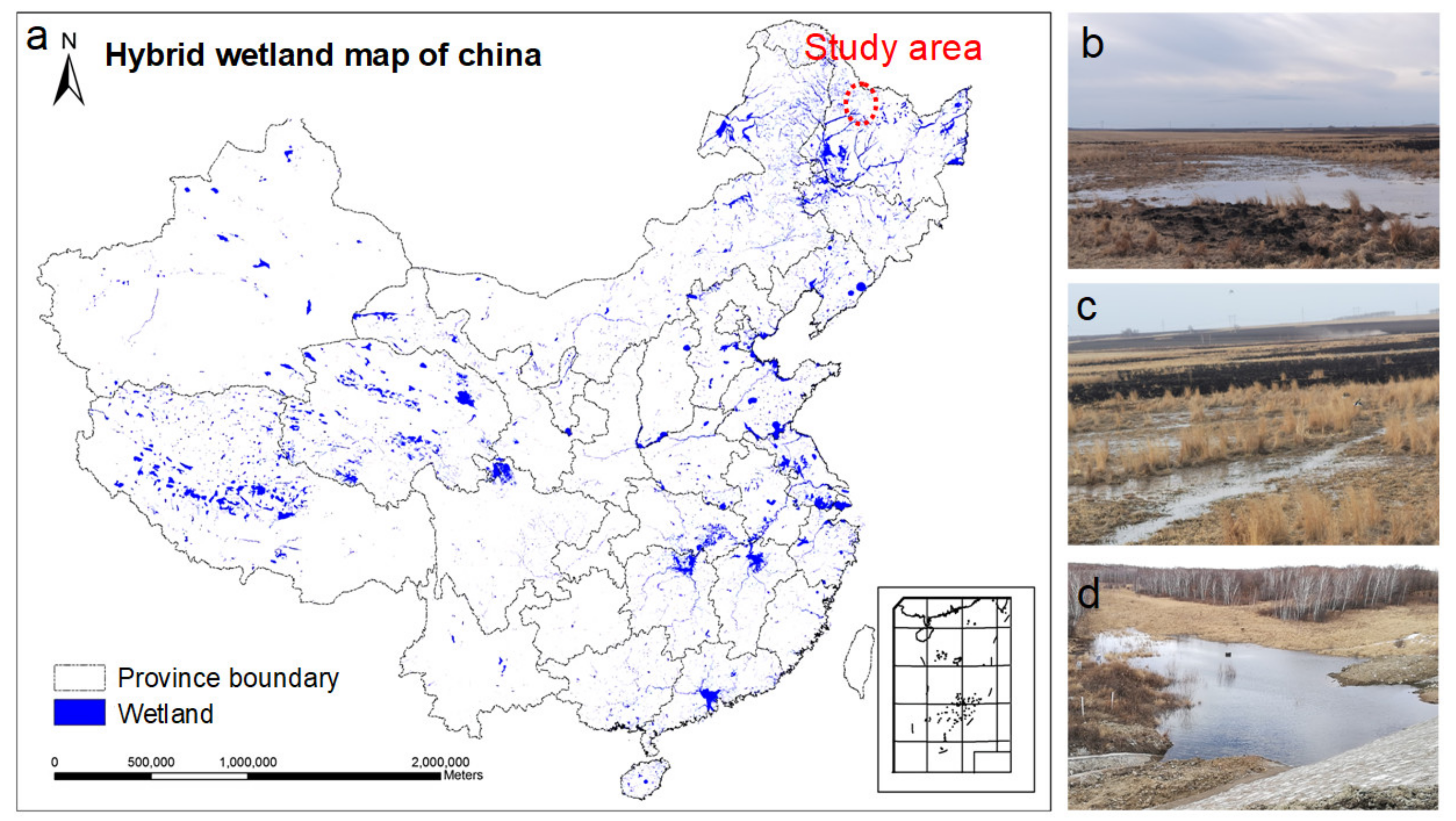
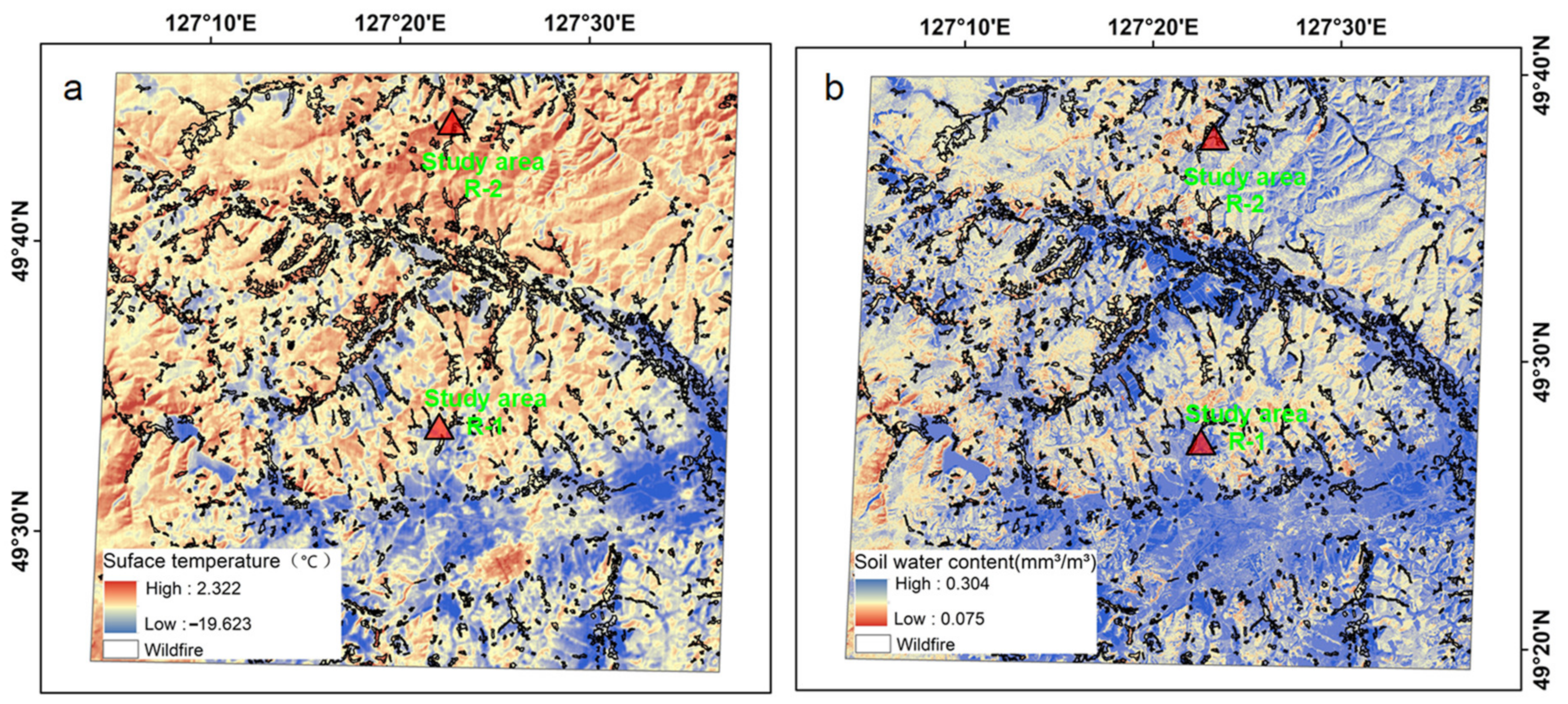
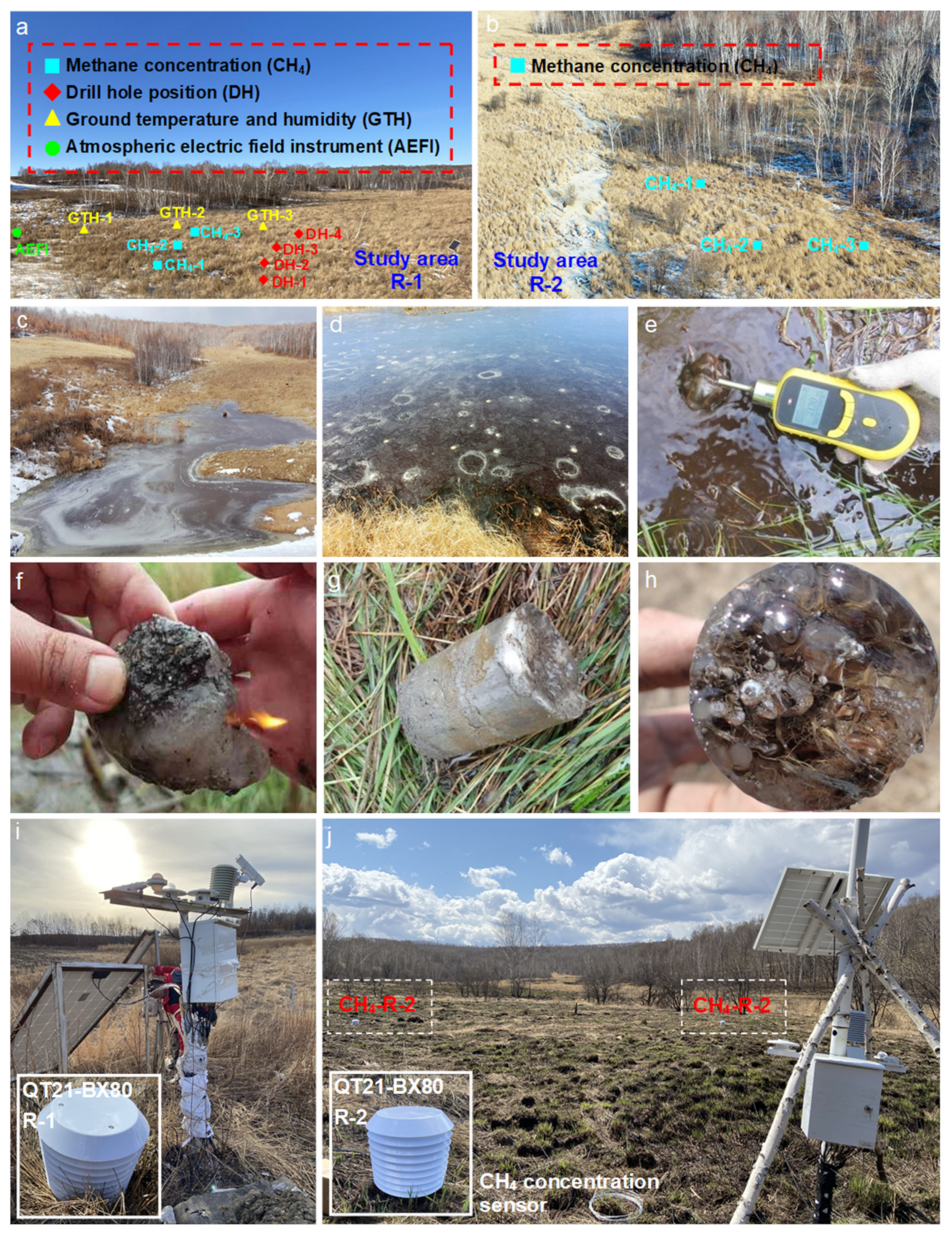



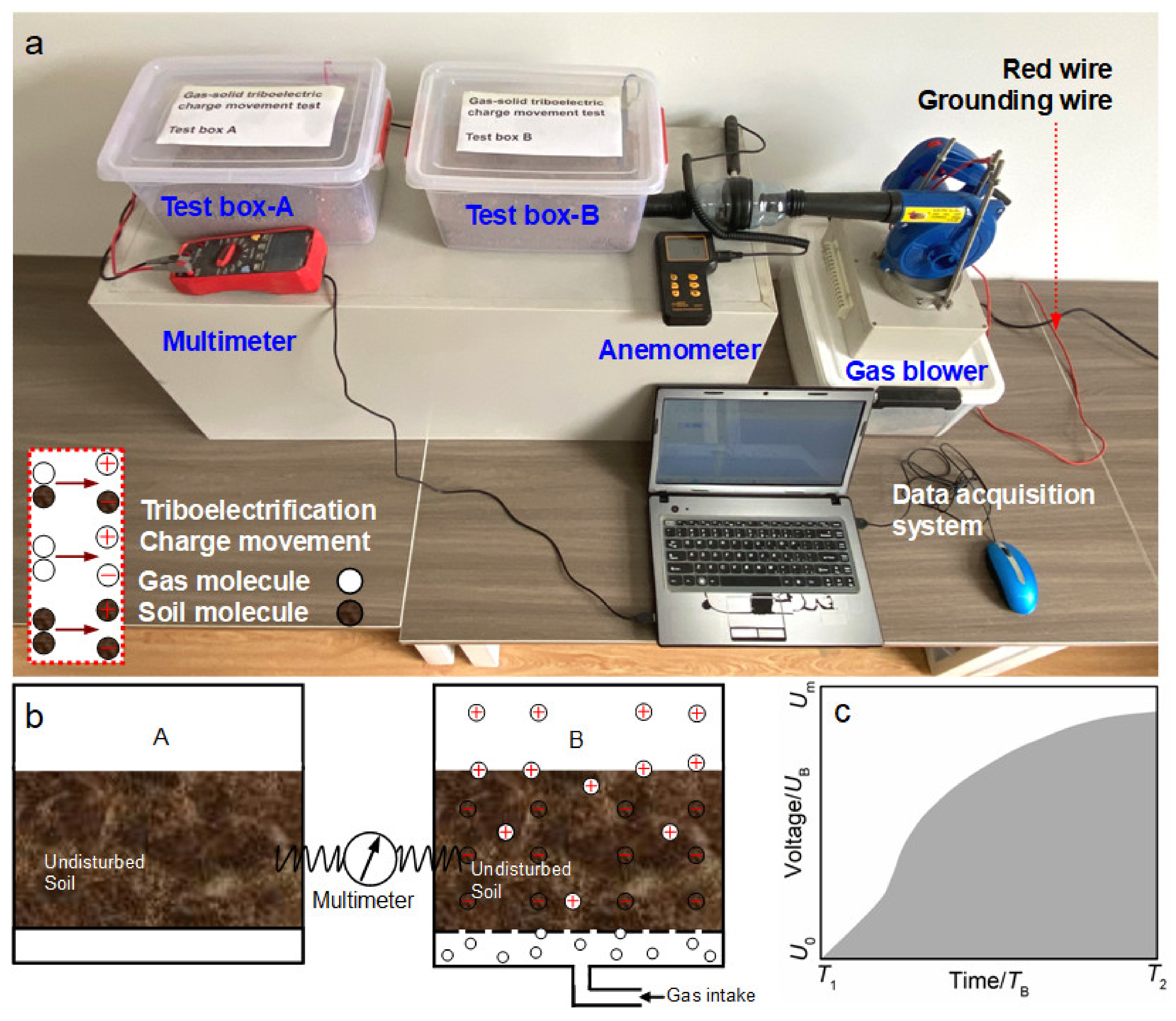
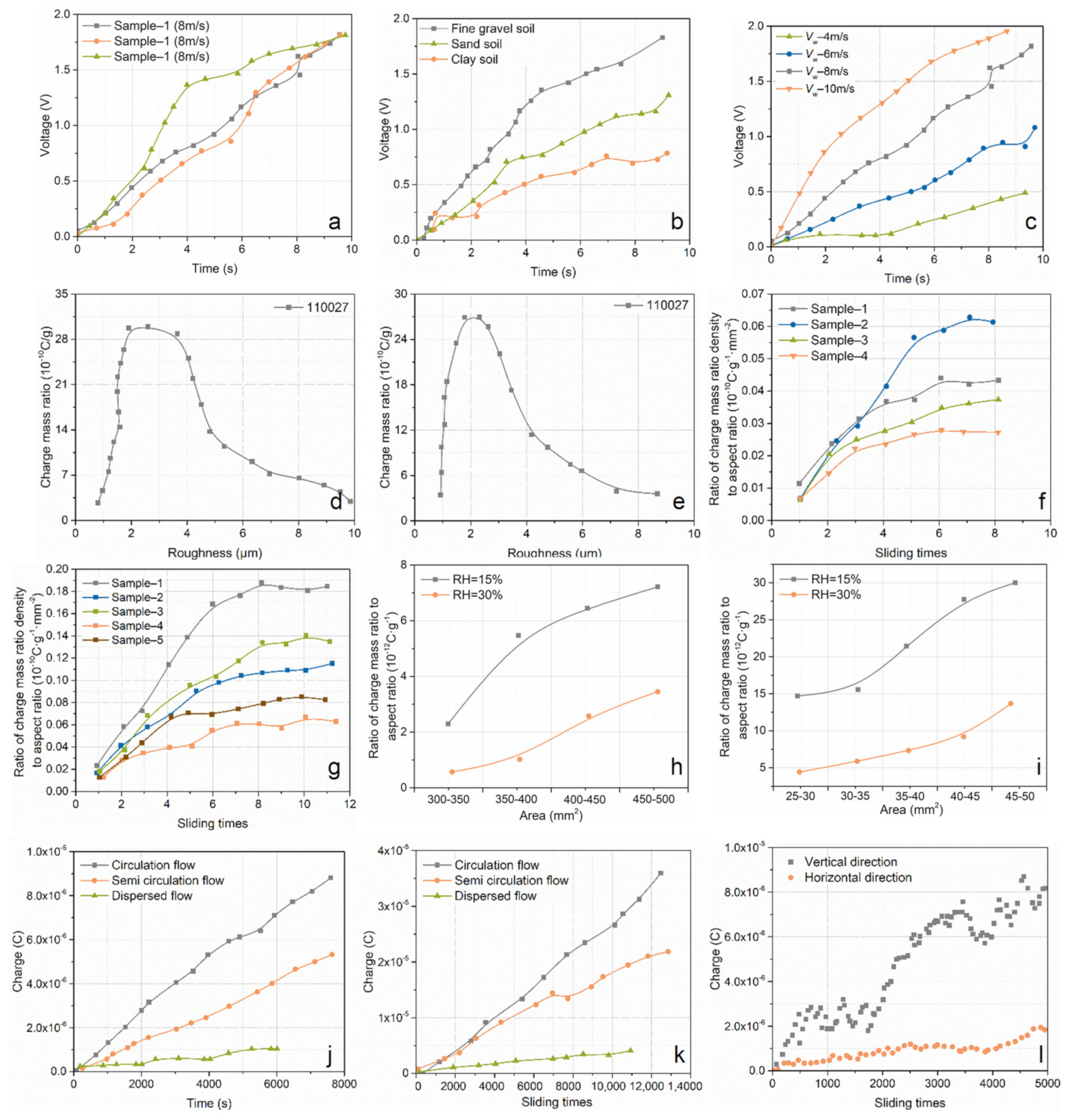
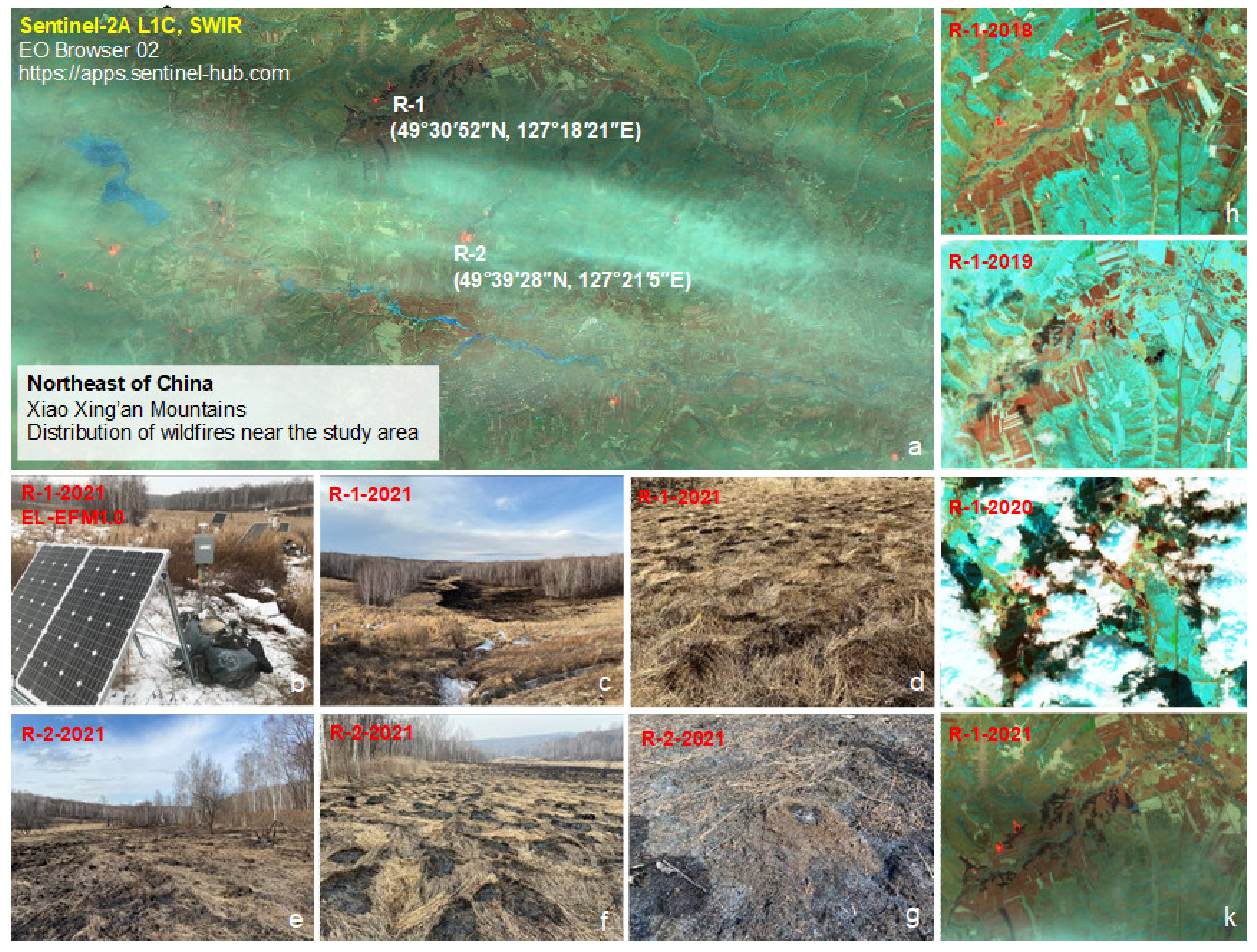
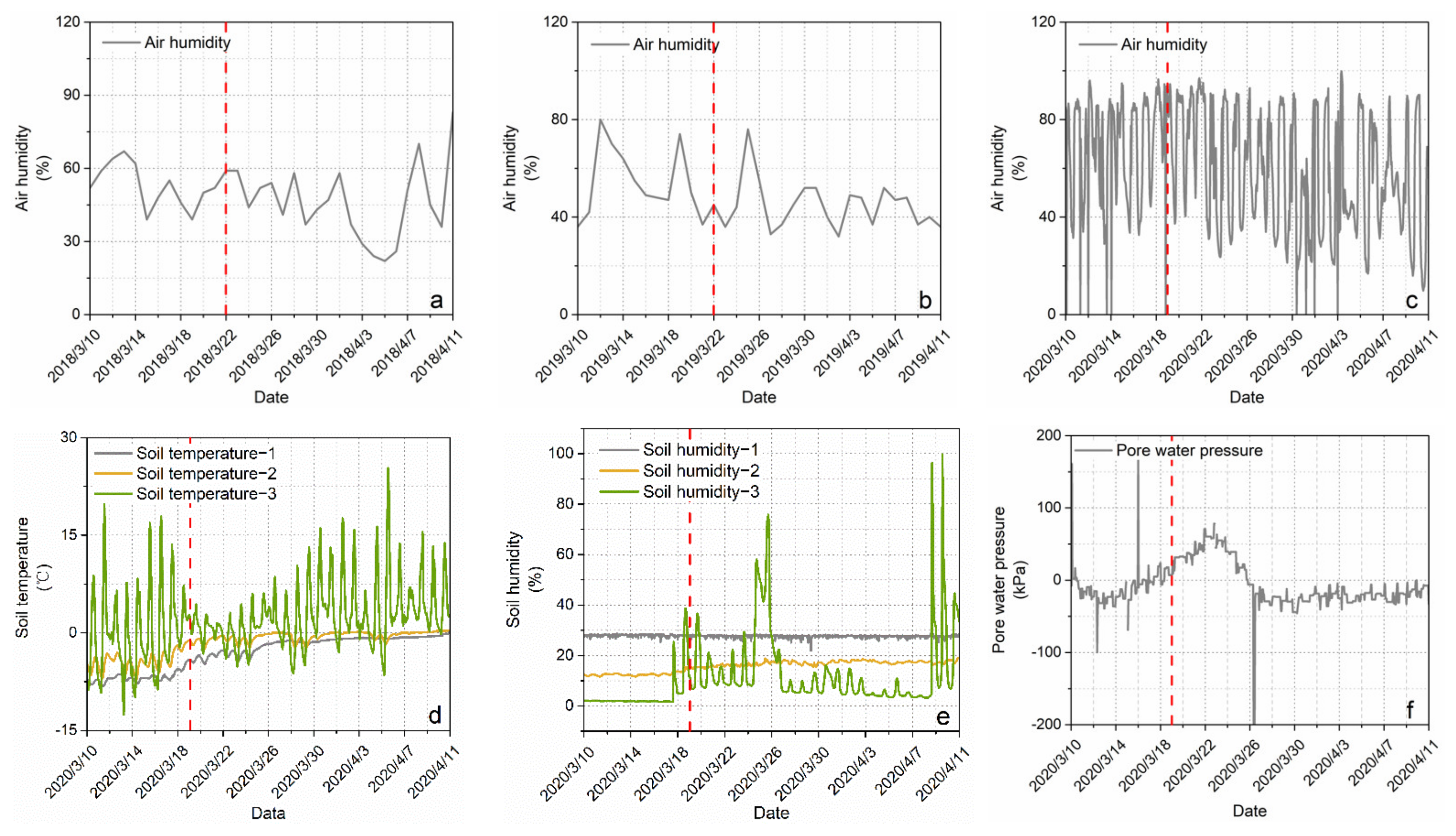
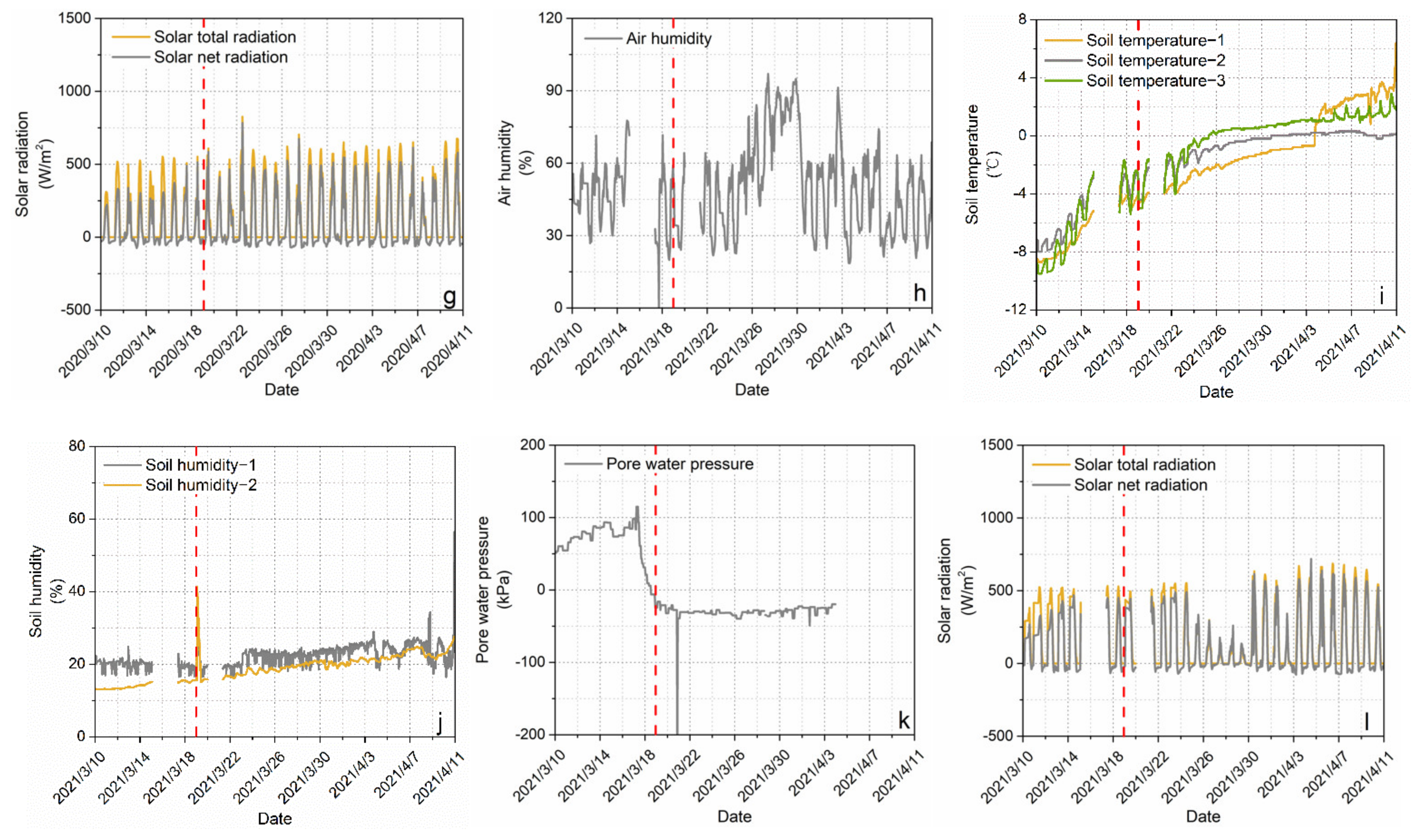
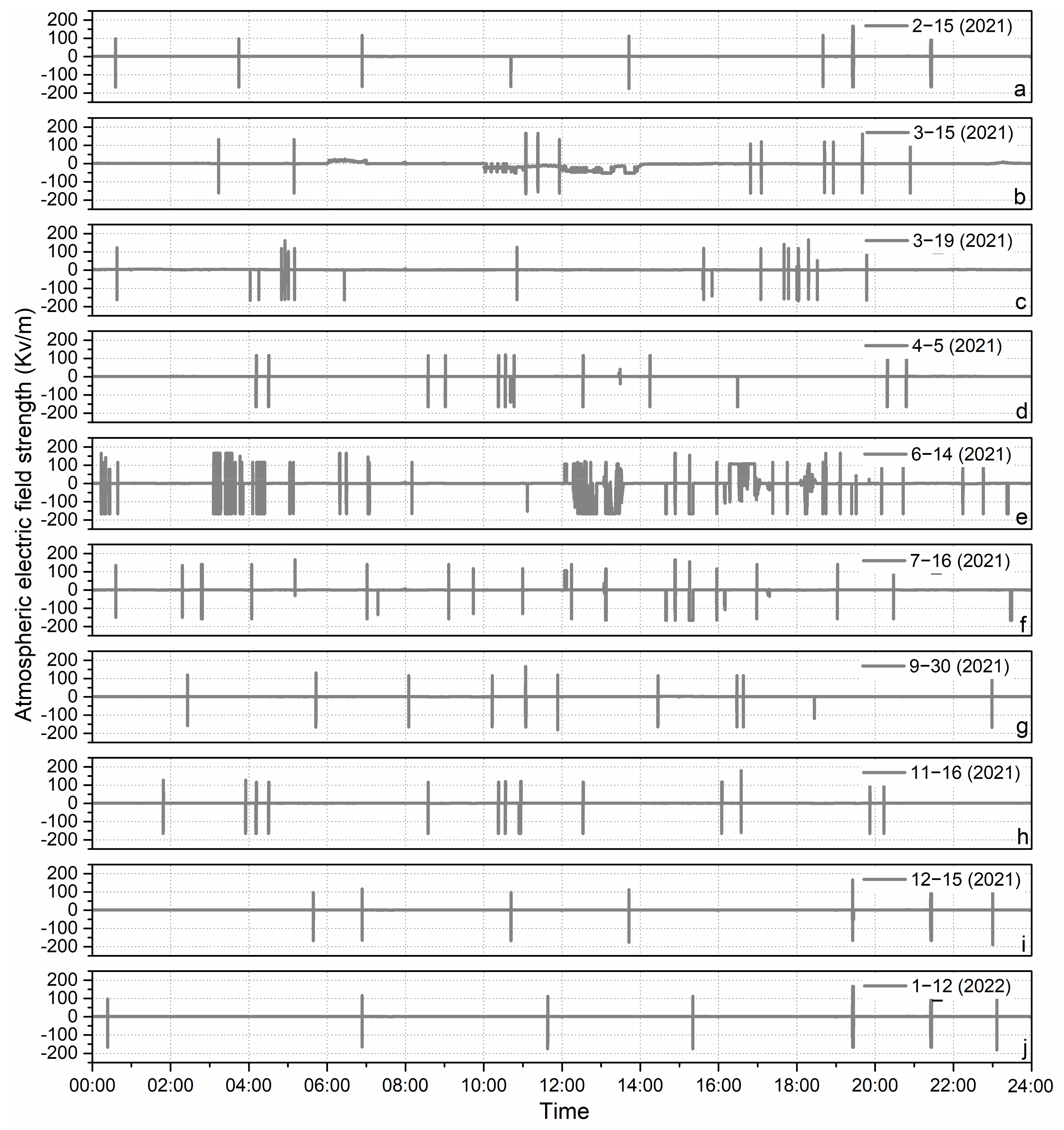
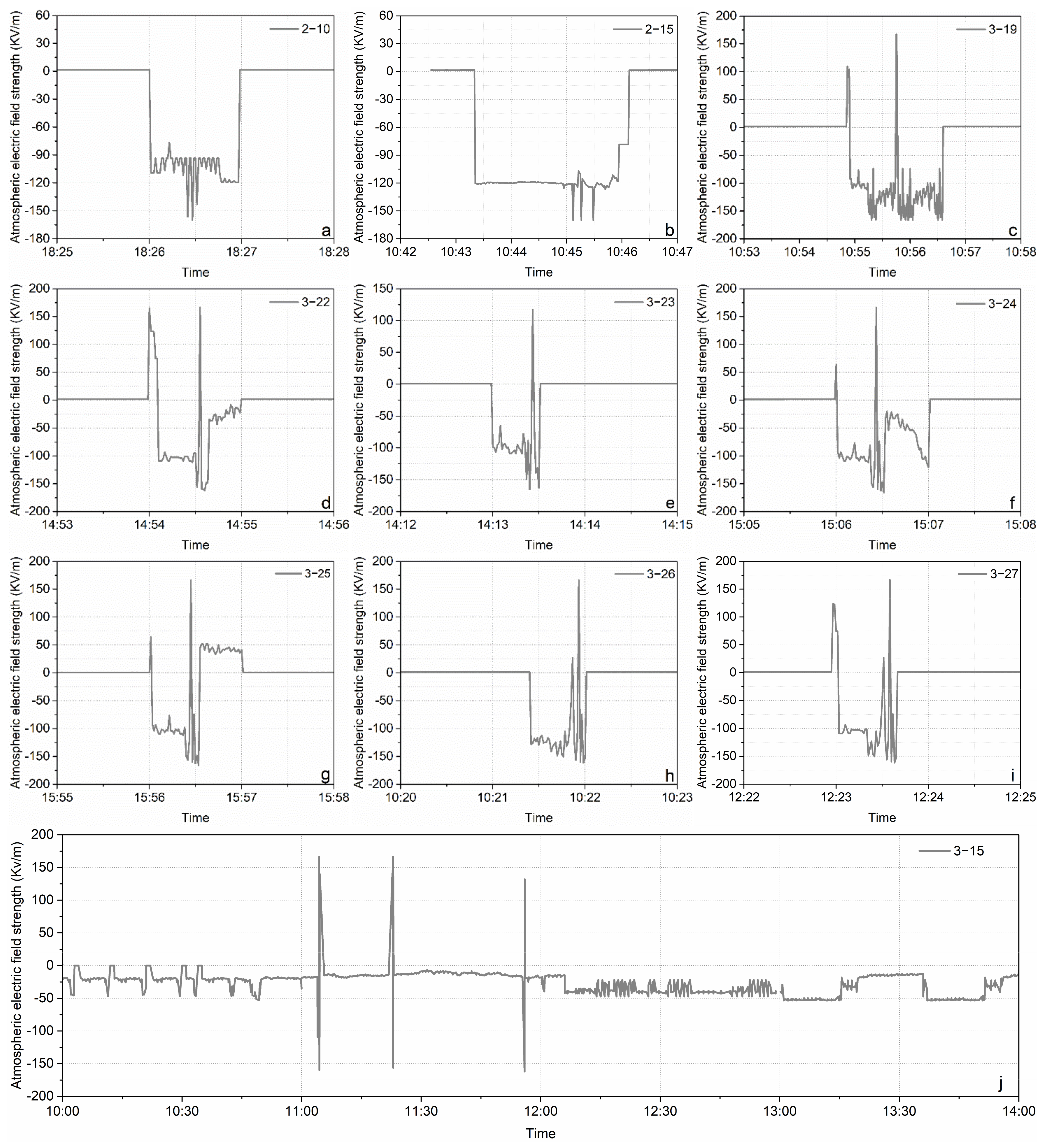

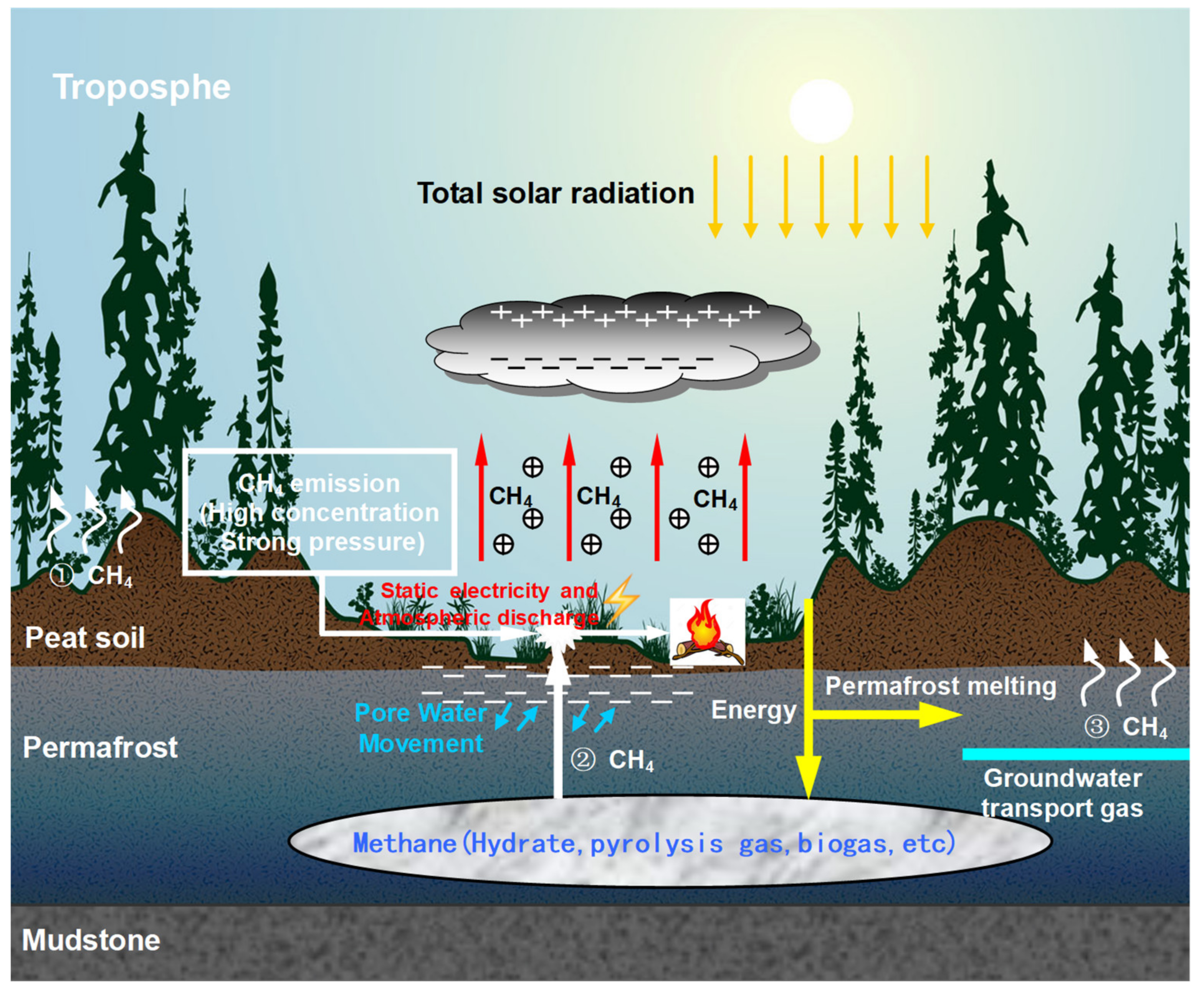
Publisher’s Note: MDPI stays neutral with regard to jurisdictional claims in published maps and institutional affiliations. |
© 2022 by the authors. Licensee MDPI, Basel, Switzerland. This article is an open access article distributed under the terms and conditions of the Creative Commons Attribution (CC BY) license (https://creativecommons.org/licenses/by/4.0/).
Share and Cite
Xu, Z.; Shan, W.; Guo, Y.; Zhang, C.; Qiu, L. Swamp Wetlands in Degraded Permafrost Areas Release Large Amounts of Methane and May Promote Wildfires through Friction Electrification. Sustainability 2022, 14, 9193. https://doi.org/10.3390/su14159193
Xu Z, Shan W, Guo Y, Zhang C, Qiu L. Swamp Wetlands in Degraded Permafrost Areas Release Large Amounts of Methane and May Promote Wildfires through Friction Electrification. Sustainability. 2022; 14(15):9193. https://doi.org/10.3390/su14159193
Chicago/Turabian StyleXu, Zhichao, Wei Shan, Ying Guo, Chengcheng Zhang, and Lisha Qiu. 2022. "Swamp Wetlands in Degraded Permafrost Areas Release Large Amounts of Methane and May Promote Wildfires through Friction Electrification" Sustainability 14, no. 15: 9193. https://doi.org/10.3390/su14159193
APA StyleXu, Z., Shan, W., Guo, Y., Zhang, C., & Qiu, L. (2022). Swamp Wetlands in Degraded Permafrost Areas Release Large Amounts of Methane and May Promote Wildfires through Friction Electrification. Sustainability, 14(15), 9193. https://doi.org/10.3390/su14159193






